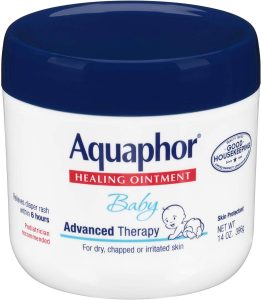You’re probably sporting a brand-new tattoo right now (or thinking about getting one real soon). And if so, you’re probably wondering how you can minimise the inevitable post-tattoo woes of sticky body fluids oozing out of your tattoo…. and later on, the soreness and the itching.
Well, if you’ve got Aquaphor in your medicine cabinet, you’re in luck! Aquaphor for tattoos is a thing, and yes, a lot of tattooed folks swear by it. So, read on to find out if this popular ointment is as good as others say it is.
Page Contents
- What exactly is Aquaphor?
- Is Aquaphor good or safe for tattoos?
- The Pros and Cons of using Aquaphor for tattoos
- How to use Aquaphor on a new tattoo
- Aquaphor vs A+D Ointment for tattoo healing
- Frequently Asked Questions about Aquaphor for tattoos:
- Which Aquaphor Healing Ointment should I use for my new tattoo? The baby one or the regular one?
- How much Aquaphor ointment to put on tattoo?
- How long to use Aquaphor on tattoos, i.e. how many days?
- How often should I put Aquaphor on my tattoo?
- Will Aquaphor burn my tattoo?
- Does Aquaphor pull ink out of tattoos?
- What are some ‘Aquaphor for tattoos’ side effects?
- Conclusion
What exactly is Aquaphor?
Ingredients: Petrolatum (41%), mineral oil, ceresin, lanolin alcohol, panthenol, glycerin, bisabolol
Aquaphor has a solid line of skincare products made for both babies and adults. If you’ve got small kids, you probably have a tube of healing ointment or diaper rash cream stowed in your diaper bag right now.
When it comes to tattoos though, when people say ‘Aquaphor for tattoos,’ they’re actually referring to the Aquaphor Healing Ointment. Now, this ointment isn’t targeted to the tattoo crowd per se. But it’s such an effective skin healing and repairing cream that tattoo enthusiasts all over the world love it!
This healing ointment is clinically proven to treat all sorts of things. From minor cuts and scrapes, moisturising dry and cracked skin, to healing chapped lips and curing minor burns.
Aquaphor is like the swiss army knife of medicated ointments. You can continue using this product long after your tattoo has healed, which is excellent value for money in my opinion!
Is Aquaphor good or safe for tattoos?
Some people think Aquaphor is exactly the same as Vaseline petroleum jelly. But that’s not the case. Vaseline does have its uses, but it’s made with 100% petrolatum which doesn’t allow the skin to breathe at all.
Aquaphor, on the other hand, is only 41% petrolatum. Apparently, this is just the right amount to let oxygen in the skin and still block harmful pathogens from infecting your tattoo. Additionally, Aquaphor contains lanolin alcohol, panthenol and glycerine. These ingredients work to moisturise and nourish the skin.
This ointment is like a two-pronged sword that protects the outside of the skin and heals the inside. So, to answer the question, yes, Aquaphor is safe for use on new tattoos.
Here’s a neat graphic from Aquaphor’s website to illustrate how this multi-purpose ointment works to heal your new tattoo:
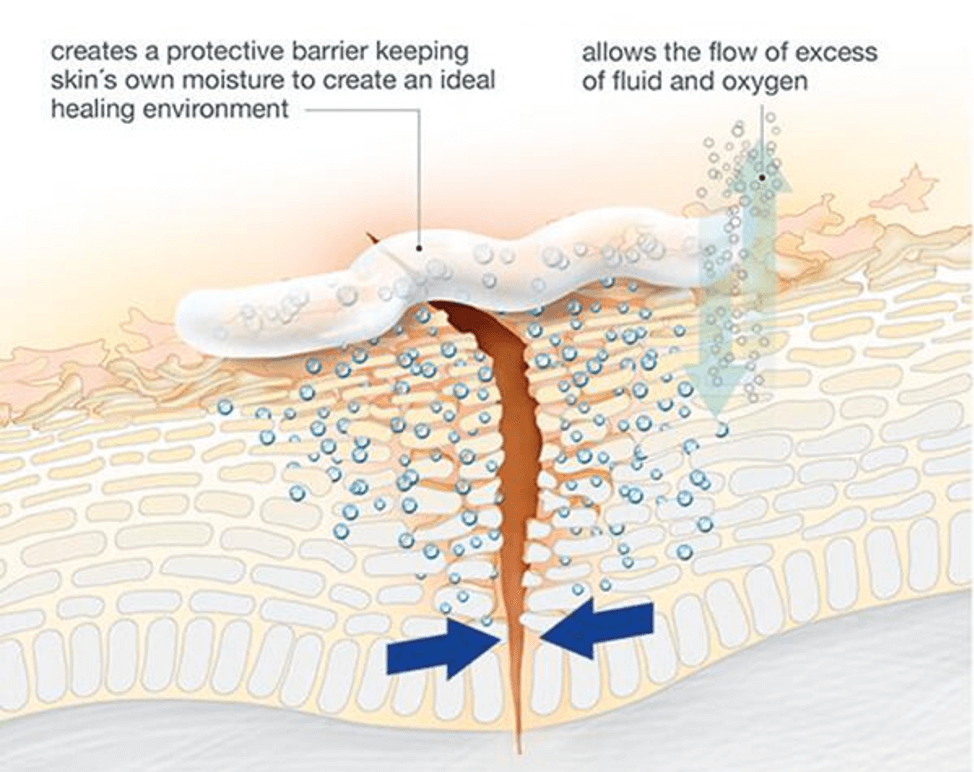
Image source: https://www.aquaphorus.com/how-it-works/
The Pros and Cons of using Aquaphor for tattoos
Now that you know Aquaphor is good and safe enough for tattoo use, here are the positive and negative aspects of using this amazing ointment.
What I really like about Aquaphor:
- Seals the skin from irritants
With gaping needle holes on your skin, you don’t want anything other than air and oxygen getting into your skin. Aquaphor’s petrolatum content is just enough to seal the skin and let the air in at the same time.
- Reduces scabbing
Tattoos are technically open wounds, and wounds will scab naturally. However, thanks to Aquaphor’s healing formula, the scabs won’t be as thick as it would be if you didn’t put ointment on it.
- Prevents infection
For all intents and purposes, Aquaphor is occlusive. It may not be as occlusive as Vaseline (which is 100% petrolatum), but it’s occlusive enough to prevent pathogens from entering the skin, which helps with preventing infections!
- Helps speed up tattoo healing process
Since your skin is being protected from the outside world and it’s being simultaneously repaired from the inside, the healing process will naturally speed up as well.
- Reduces itching
The worst thing about getting a tattoo is the itch when it finally starts healing up. Don’t get me wrong, you’ll most likely still experience itching even if you apply Aquaphor regularly. However, it won’t be as bad as when you dry heal your tattoo!
- Non-comedogenic
If you’ve got sensitive skin and you’re prone to getting clogged up pores, then you’ll like Aquaphor. It’s non-comedogenic so it’s not going to cause acne breakouts UNLESS you slather on a super thick layer on your skin.
- Very affordable
A 14oz jar retails for around 15 pounds on Amazon, but you can probably get it cheaper at supermarkets or pharmacies nearby.
- Widely available
You’ll find Aquaphor for sale in many places. It’s so widely available, in fact, that you may already have a tube or jar stored in your medicine cabinet!
What I don’t like about Aquaphor:
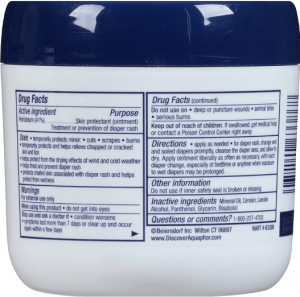
- Can cause skin breakouts
Aquaphor’s non-comedogenic, but if you go overboard with the application, then don’t be surprised to see pimples pop up overnight! It may only be 41% petrolatum, but it may very well be a hundred percent if you smother your skin with it!
- You may be sensitive to some ingredients
Aquaphor’s supposed to be safe for most skin types. Their adult and baby ointments use the same ingredients, which means it’s safe for use even on babies. But some people just don’t react well to petrolatum. If you’re looking for a more natural ointment, check out Hustle Butter instead.
How to use Aquaphor on a new tattoo
Now that you know Aquaphor’s got a couple of downsides too, you need to know how to use this ointment properly, so you don’t run into problems later on.
Step 1: Clean the area properly
Remove the cling film your tattooist used to protect the tattoo. Then wash the area with warm water and unscented, antibacterial soap (here’s our list of the best tattoo soaps). This will break down the blood, pus, and plasma, so your skin can finally breathe. It will sting a bit, but it won’t be as bad as when you were getting the tattoo done.
Anyway, this step is extremely important for brand-new tattoos. Since Aquaphor is an occlusive ointment, any dirt that gets trapped underneath it won’t be able to get out until the next wash. This increases the likelihood of getting an infection if you’re not careful with this step.
Step 2: Let skin dry partially
You can either air dry the skin or pat it gently with clean cloth or kitchen roll. You don’t want to let it get too dry though as you want some moisture in before you apply Aquaphor.
Step 3: Apply a very thin layer of Aquaphor on tattoo
A thin layer is all you need to protect your new tattoo. Too much and your skin won’t be able to breathe. Too little and you’ll miss a spot that would be a likely entry point for pathogens. That said, make sure you apply that thin layer evenly to ensure the tattoo underneath heals properly.
Step 4: Repeat steps 1 to 3 twice or thrice daily UNTIL your tattoo stops oozing plasma
Once your tattoo stops oozing, it means you’re now ready for the next stage of the aftercare process – moisturising. We highly recommend using After Inked vegan tattoo aftercare lotion. It’s enriched with grapeseed oil, shea butter, jojoba seed oil, and other tattoo-friendly ingredients. The entire team here absolutely loves this lotion!
Related article: Tattoos and Coconut Oil: Yay or Nay?
Aquaphor vs A+D Ointment for tattoo healing
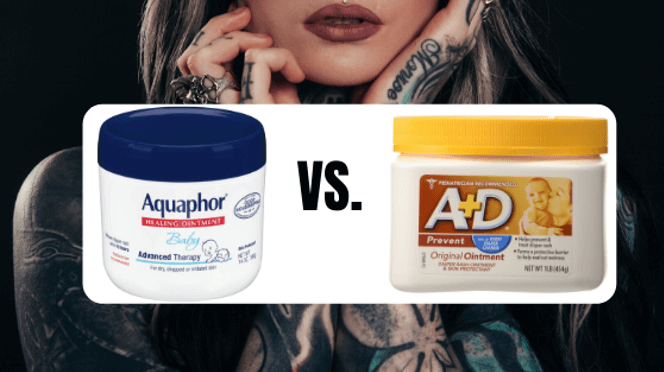
Most tattooists recommend either Aquaphor or A+D Ointment during the initial stages of tattoo healing. Here are their similarities and differences:
Protection: Both products use petrolatum and mineral oil, with Aquaphor being made of 41% petrolatum and A+D at 53.4%. This means A+D is slightly more occlusive, but will definitely still allow oxygen in the skin.
Healing and nourishing: Aquaphor has both panthenol and glycerine to heal and nourish the skin. But A+D is formulated with lanolin (15.5%) and thanks to cod liver oil, it has vitamins A & D in it as well.
Fragrance: Aquaphor is fragrance-free while A+D has fragrance listed in its ingredients.
Price: Aquaphor is a few pounds cheaper than A+D, so that’s a plus for Aquaphor.
Texture: Since Aquaphor has lower petrolatum content, it is slightly less greasy than A+D.
Summary: Honestly, picking one over the other is a personal preference. Both ointments work great at healing tattoos. However, I would recommend Aquaphor if you’re allergic to lanolin (some people are) and if you already have a tube or jar at home! Otherwise, you really can’t go wrong with either one.
Frequently Asked Questions about Aquaphor for tattoos:
Which Aquaphor Healing Ointment should I use for my new tattoo? The baby one or the regular one?
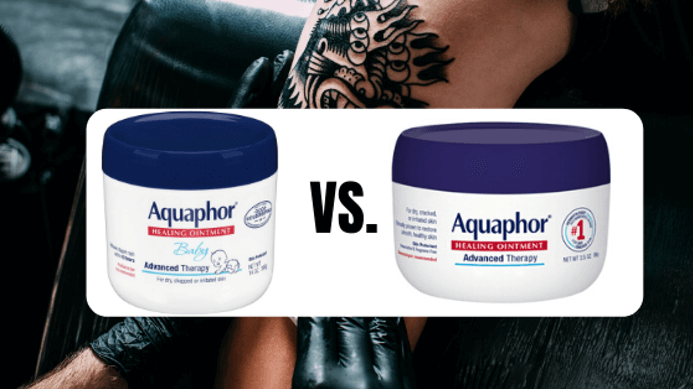
Well, both variations contain the same ingredients, but the baby ointment is formulated especially for baby skin. It’s supposed to be more gentle, so if you have sensitive skin, I highly recommend buying the Aquaphor Baby Healing Ointment. Otherwise, the regular one will work just fine for you!
How much Aquaphor ointment to put on tattoo?
This ointment is great, yes, but you need to watch out how much product you slather on your skin! It may not be a 100% petroleum jelly-based product, but it still has occlusive properties.
This means if you slap on a thick layer, your skin won’t be able to get much-needed oxygen to aid in the healing process. This leads to a slower rate of healing, and worse, can possibly cause skin irritations and acne breakouts!
When it comes to tattoos and ointments, no matter which brand you ultimately end up using, a very thin layer is all you need to put on.
How long to use Aquaphor on tattoos, i.e. how many days?
Most experts recommend using Aquaphor from day 1 until the tattoo stops oozing clear plasma. However, with ingredients like panthenol and glycerine, Aquaphor will continue moisturising your tattoo even when it’s already fully healed. However, it’s not primarily a moisturiser, so it won’t hydrate the skin as well as a good tattoo moisturiser, lotion, or cream will.
How often should I put Aquaphor on my tattoo?
Twice or thrice daily should suffice. You don’t want to wash and clean the area every two hours because it’s going to dry out the skin. So, limit the washing to 3x daily at most and apply a thin layer of Aquaphor healing ointment after.
Will Aquaphor burn my tattoo?
It shouldn’t. But for fresh tattoos, you might experience a stinging or burning sensation. It should go away after a few minutes. If the pain worsens instead of becoming more bearable, wash the area again with soap and water. Call up your tattooist or your GP and ask for advice as you may be allergic to Aquaphor. Or, worse, your tattoo may already be infected.
Does Aquaphor pull ink out of tattoos?
Well, this is a scary one. You obviously don’t want your healing ointment pulling ink out of your skin. Here’s the answer:
If the tattoo was done correctly, that is, ink was deposited in the dermis layer, then no, Aquaphor won’t pull out ink in the dermis. However, take note that some ink will also get on the epidermis (this is totally normal). Now, the epidermis skin cells regenerate constantly and the ink deposited there WILL slough off.
So, if you see ink coming off the next time you wash the tattoo, don’t worry, it’s not Aquaphor’s fault. That ink from the epidermis will come off whether you use Aquaphor or not.
What are some ‘Aquaphor for tattoos’ side effects?
Aquaphor’s quite safe to use for all ages. In fact, the baby healing ointment is paediatrician recommended, and the regular version is dermatologist recommended. It’s clinically proven to repair minor cuts and scrapes, dry and cracked skin, and more.
However, if you experience any stinging, burning, redness or irritation, please don’t ignore it. If you think your tattoo’s infected – whether it be because of Aquaphor or some other aftercare product – speak to your GP immediately.
Conclusion
Getting your brand-new tattoo to heal up fast isn’t exactly rocket science. With discipline and some good aftercare products like Aquaphor, your new tattoo will heal up in no time at all!

